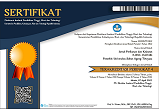Characterization of Glucosamine Nano Particles from Chitosan Using Ultrasonicators and Ball Milling Methods
Abstract
Oral consumption of glucosamine hydrochloride can worsen side effects in the human body, so the development of nanoparticles from glucosamine hydrochloride is needed as a topical preparation in treating osteoarthritis. This study aims to determine the differences in the characteristics of nanoparticles from shrimp shell glucosamine made ultrasonic and ball milling. For the production of glucosamine from shrimp shells, the acid hydrolysis method was used using 37% HCL solution, then washed with IPA solution until glucosamine powder was formed, then the yield and FTIR tests were carried out. Preparation of glucosamine nanoparticles using the ultrasonic method, namely glucosamine with a 37% HCl mixture sonicated using an ultrasonicator, and another method using a ball mill to fission glucosamine to obtain powdered glucosamine nanoparticles. The powder obtained from the two methods was then characterized using a scanning electron microscope (SEM) to determine the morphological condition of the solid. The results of the glucosamine test obtained a yield of 83.65%, and the absorption pattern of the Fourier transform infrared (FTIR) spectrum showed 99.82% so that it met the quality standards proving that glucosamine hydrolysis was successful. The powder characterization obtained by SEM aims to determine the size characteristics of the glucosamine nanoparticles obtained. The resulting powder nanoparticles are yellow-white. The SEM photo results show the morphology of the particles with an uneven surface. The results of the Scanning Electron Microscope (SEM) test showed that the particle size of glucosamine by ultrasonic and ball milling methods were 83.56 nm and 61.16 nm, respectively.
Keywords
Full Text:
PDFDOI: http://dx.doi.org/10.33512/jpk.v11i2.12886
Refbacks
- There are currently no refbacks.



_-_Copy1.png)